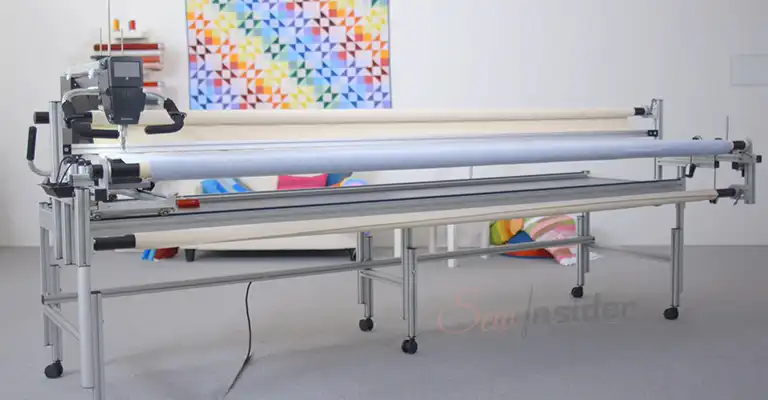Loading a quilt on a Gammill Longarm machine is a much quicker and easier method compared to other methods like floating. To load a quilt on your long-arm machine, first, pin the backing fabric to the long-arm machine. Now add the batting between the second and third rail and lock the machine.
After that, do the same with the quilt top and make sure both of these are aligned perfectly straight and square and do not have any wrinkles. Now use some quilt clips to add tension to it. To know more about how to load a quilt on a Gammill Longarm machine, keep digging further.

How Do Load a Quilt on a Gammill Longarm Machine
A longarm machine is a complex machine consisting of a work table, fabric roller, sewing machine, and a heavy metal frame that holds all of these machines altogether.
There are several popular ways to load a quilt on a Gammill longarm machine. And every single method might vary depending on the machine you have or the model number of your machine. But the key things are all the same.
Compared to other methods, loading the quilt on a longarm machine is much easier and quicker. At the same time, loading the quilt goes easy on your hands and back as well. Whereas floating your quilt or traditional quilt basting might be more tiresome and more time-consuming for you.
Before you go on with the loading task, you have to understand how to find the midpoint of the quilt top as well as the grain line of the fabric. This is quite simple, just fold the fabric in half and then crease the center spot. After that use the center point of the leader cloth to line up the spot and pin it.
To load a quilt on a Gammill longarm frame, follow these simple steps mentioned down below:
Step 1: Pin the Backing Fabric
Once you have a clear idea about the grainline of the fabric and the mid-point of the quilt top, it is time for the pinning-up task. And that task is quite time-consuming if you want to do it the right way.
While pinning up, make sure that the fabric does not stretch or skew out of shape. And if you are done pinning up the backing, it is time for you to roll up. While you are rolling the backing fabric up to the rail, make sure that the fabric remains smooth and remove the wrinkles.
And also make sure that the alignment of the backing fabric to the rail remains square and straight.
Step 2: Add the Batting to the Rail
Now that you are done with the pinning, it is time for you to stick the batting between the second and third rails. And while you are on it, make sure that the batting is spread out evenly and smoothly.
Step 3: Lock the Longarm Machine
Now use the lock feature of your longarm machine to make sure that the stitches are going straight to the length of the frame. This way you can place the quilt top nicely aligned with the edge of the batting.
Step 4: Tuck the Quilt Top
After that place the quilt top on the batting between the second and third rails and smooth it out.
Step 5: Use Some Quilt Clips
Now at this point, you can pin the quilt top, if you want. But that is going to be much more time-consuming, and you might not find it worthwhile. To lock the quilt top and the batting to the second rail, you can use some quilt clips. This is a nice way to add some tension to the quilt top. And that’s it. The loading process can take up to 15 to 30 minutes, depending on your expertise and practice.
In short, pinning the backing fabric to the machine is the most time-consuming part of the task. And then add the batting between the second and third rails. Now lock the longarm machine. And then add the quilt top just like the batting. After that, you can use some clips to add tension to the quilt top. And you are done.
Frequently Asked Questions and Answers
Why is Gammill skipping stitches?
Sometimes, the needle bar does not remain in its position due to different types of fabrics, thick seams, and heavy silk screens. This can cause the skipping of the stitches. Also, the old and worn needle can make the machine skip stitches as well. To solve the issue, you can try replacing the old needle with a new one.
Why does my thread keep breaking on my Longarm?
Most of this issue occurs due to extended tension on the threads. If the tension settings are too tight for the threads to take, you will end up having a broken thread now and then.
Conclusion
Floating the quilt top can be a tiresome and time-consuming task for some people. But now that you know how to load a quilt on a Gammill Longarm machine, you can save both your time and your back. So what are you waiting for? Let’s get started with the quilting!
Leave a Reply